How can utilising basic drawing techniques [abstractly] and then taking them through an impromptu rendering process at the bench, via materials and techniques, inform an established contemporary practice in an effort to comprehend and reinterpret drawing from a traditional/fine jewellery design process?
Traditional jewellery design is primarily focused around gems through technical drawings, that leave no room for interpretation at the bench. This is the complete opposite to my studio practice, where the objects I create inform my ideas rather than drawings. Yet, recent work has seen me using technical drawing tools in a way that is not representative of the precision outcomes they were designed for.
Fine jewellery design like Cartier and Harry Winston etc., is well renowned for creating one-of-a-kind, commissioned pieces that are often for the rich and famous. It is intended to create a piece that fits with the clients vision, intent or the gems they themselves provide and communicate an outcome with precision between the client and the maker.
It is difficult to define when the first technical/design drawing for jewellery came about but I believe technical drawing began in the 15th century with its best known artist being Leonardo da Vinci. Preceding this, basic knowledge of geometry was BC by mathematician’s, such as Greek philosopher Pythagoras of Samos. Computer technology has increased computer assisted methods of design with the use of programs such as CAD. Yet, drawing techniques done by hand are still taught and prevalent to fine jewellery design today but I feel it is something of an ‘inbetweener’ or hidden dimension.


